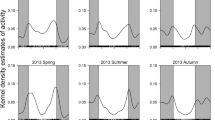Abstract
Alpine musk deer (Moschus sifanicus), well-known for their musk production, are endemic to western China. Due to historical unrestricted illegal hunting and habitat loss, captive farming has been employed as a means of conserving this endangered species and developing sustainable musk harvesting techniques. For captive animals, an understanding of behavioral characteristics is vital to improve management practices. This study addressed a lack of information regarding the behavioral characteristics of alpine musk deer; specifically daily activity patterns in respect to gender and reproductive season. From August 2002 to January 2003, focal sampling was employed to observe 32 adult captive alpine musk deer (13 females and 19 males), at Xinglongshan Musk Deer Farm (XMDF), located at Xinglongshan National Nature Reserve, Gansu Province, China. Results indicated that the general behavioral patterns were similar between female and male captive alpine musk deer throughout both reproductive and non-reproductive seasons (rut and pre-rut season). Both male and female alpine musk deer demonstrated tail-pasting behavior during rut season, a previously male-only behavior trait. Female musk deer also rested comparatively more than males during pre-rut season.
Similar content being viewed by others
References
Dimond S. & Lazarus J. 1974. The problem of vigilance in animal life. Brain. Behav. Evol. 9: 60–79. DOI 10.1159/000123655
Du W. & Sheng H. 1996. The research on the relationship of mother-young in captive forest musk deer. Acta Theriol. Sin. 16: 89–94. [in Chinese with English abstract]
Green M.J.B. 1987. Scent-marking in the Himalayan musk deer (Moschus chrysogaster). J. Zool. 1: 721–737.
Homes V. 1999. On the Scent: Conserving Musk Deer, the Uses of Musk and Europe’s Role in its Trade, TRAFFIC Network, 57 pp.
Jiang Y. 1998. The reproduction of the captive alpine musk deer. Chin. J. Zool. 21(4): 23–25. [in Chinese with English abstract]
Meng X., Yang Q. & Feng Z. 2003a. Timing and synchrony of parturition in alpine musk deer. Folia Zool. 52: 39–50.
Meng X., Yang Q. & Feng Z. 2003b. The temporal estrous patterns of female alpine musk deer in captivity. Appl. Anim. Behav. Sci. 82: 75–85. DOI 10.1016/S0168-1591(03)00013-3
Meng X., Zhou C., Hu J., Li C., Meng Z., Feng J., Zhou Y. & Zhu J. 2006. The musk deer farming in China. Anim. Sci. 82: 1–6. DOI 10.1079/ASC200516
Parry-Jones R. & Wu J.Y. 2001. Musk Deer Farming as Conservation Tool in China. TRAFFIC Network, 36 pp.
Relyea R.A. & Demarais S. 1994. Desert mule deer activity of during the breeding season. J. Mammal. 75: 940–949.
Ruckstuhl K.E., Festa-Bianchet M. & Jorgenson J.T. 2003. Bite rates in Rocky Mountain bighorn sheep (Ovis canadensis) effects of season, age, sex and reproductive status. Behav. Ecol. Sociobiol. 54: 167–173. DOI 10.1007/s00265-003-0615-2
Schütz K.E., Forkman B. & Jensen P. 2001. Domestication effects on foraging strategy, social behavior and different fear responses: a comparison between the red junglefowl (Gallus gallus) and a modern layer strain. Appl. Anim. Behav. Sci. 74: 1–14. DOI 10.1016/S0168-159(01)00156-3
Sheng H. & Ohtaishi N. 1993. The status of deer in China, pp. 1–11. In: Ohtaishi N. & Sheng H. (eds), Deer of China: Biology and Management, Elsevier Science Publishers, Amsterdam, Netherlands.
Shi J., Dunbar R.I.M., Buckland D. & Millar D. 2003. Daytime activity budgets of feral goats (Capra hircus) on the Isle of Rum: influence of season, age, and sex. Can. J. Zool. 81: 803–815. DOI 10.1139/z03-055
Sokolov V.E. 1984. Chemical communication of some species of rodents, ungulates and carnivores. Acta Zool. Fenn. 171: 67–69.
Zhang B. 1979. The taming and raising of musk deer. Agriculture Press, Beijing, China, pp. 43–56.
Zhou Y., Meng X., Feng J., Yang Q., Feng Z., Xia L. & Bartoš L. 2004. Review of the distribution, status and conservation of musk deer in China. Folia Zool. 53: 129–140.
Author information
Authors and Affiliations
Corresponding author
Rights and permissions
About this article
Cite this article
Meng, X., Yang, Q., Feng, Z. et al. Seasonal behavioral patterns of captive alpine musk deer (Moschus sifanicus): Rut and pre-rut comparisons. Biologia 63, 594–598 (2008). https://doi.org/10.2478/s11756-008-0085-0
Received:
Accepted:
Published:
Issue Date:
DOI: https://doi.org/10.2478/s11756-008-0085-0




